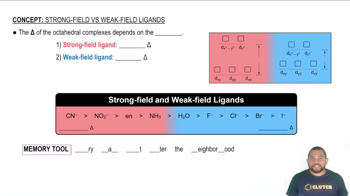Which of the following diagrams most likely represents an ionic compound, and which represents a molecular one? Explain your choice.
In the Millikan oil-drop experiment (see Figure 2.5), the tiny oil drops are observed through the viewing lens as rising, stationary, or falling, as shown here. (a) What causes their rate of fall to vary from their rate in the absence of an electric field?

Verified Solution
Key Concepts
Electric Field

Gravitational Force

Charge of the Droplets

Five of the boxes in the following periodic table are colored. Predict the charge on the ion associated with each of these elements.
The following diagram represents an ionic compound in which the red spheres represent cations and the blue spheres represent anions. Which of the following formulas is consistent with the drawing? KBr, K2SO4, Ca1NO322, Fe21SO423.
A 1.0-g sample of carbon dioxide (CO2) is fully decomposed into its elements, yielding 0.273 g of carbon and 0.727 g of oxygen. (a) What is the ratio of the mass of O to C?
A 1.0-g sample of carbon dioxide (CO2) is fully decomposed into its elements, yielding 0.273 g of carbon and 0.727 g of oxygen. (b) If a sample of a different compound decomposes into 0.429 g of carbon and 0.571 g of oxygen, what is its ratio of the mass of O to C?
A 1.0-g sample of carbon dioxide (CO2) is fully decomposed into its elements, yielding 0.273 g of carbon and 0.727 g of oxygen. If a sample of a different compound decomposes into 0.429 g of carbon and 0.571 g of oxygen, what is its ratio of the mass of O to C? (c) According to Dalton's atomic theory, what is the empirical formula of the second compound?
